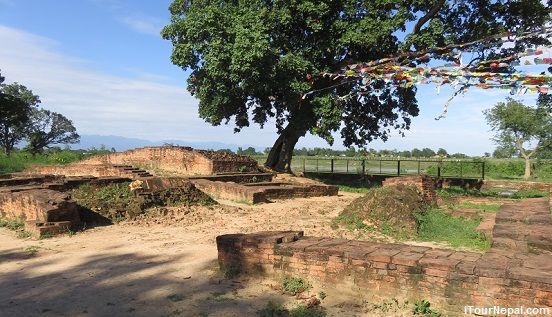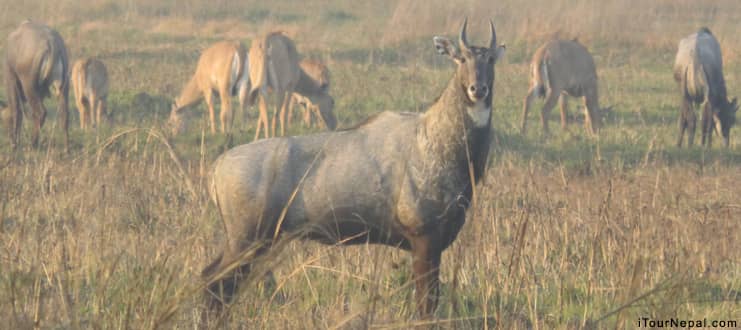- Home
- About us
- Nepal
- Tibet
- Bhutan
- Nepal Tour Packages
- Kathmandu Tour
- Nepal Tour 5 day
- Chitwan Pokhara Tour 8 day
- All Nepal Tour 12 day
- Nepal Driving Tour 12 day
- Family Tour in Nepal
- Nepal Tour Special 14 day
- Heritage Tour 14 day
- Art & Craft Tour
- Birding Tour in Nepal
- Lumbini Tour
- Honeymoon in Nepal
- Mustang Jeep Tour
- Tiji Festival Tour
- Wildlife safari Tour
- Hindu pilgrimage tour
- Buddhist Pilgrimage Tour
- Yoga Meditation Tour
- Volunteer Nepal
- Nepal Treks
- Tibet Tour Package
- Bhutan Tour Package
- Travel Tips
- Gallery
- Contact
- Blog
- XML
4 sightseeing around Lumbini
Visiting Lumbini, the birthplace of Buddha, is also an opportunity to see the culture and ecology of the Terai. Lumbini and its surroundings have about 60 archaeological sites related to Buddha, dating back to as early as the 8th century BC. The ruins of the palace, stupas and monasteries of the ancient Kapilavastu kingdom are one of the important archaeological sites of Nepal.
Here are four sightseeing spots and things to do in Lumbini.
1 Visit sacred garden and Mayadevi temple in the evening

Most people visit the Mayadevi temple, the birthplace of Buddha in the afternoon. But if you want to feel the vibe of the prayers, visit the sacred garden in the evening. This is when monks and pilgrims come to offer oil lamps and chant hymns. Sit in a corner and immerse in the enchanting orison. Watch the silhouette of the Mayadevi temple in oil lamps and its reflection on the Pushkarini pond.
Mayadevi temple shelters the recently rediscovered marker stone and layers of temple ruins dating back to the 3rd century BC. The marker stone was kept at the exact birthplace of Buddha, which was later buried under the debris of temples built at different times in history. The 6 m tall Ashokan pillar from 3rd BC with an inscription mentioning Emperor Asoka’s visit to the birthplace of Buddha still stands next to the temple. The Puskarini pond lies to the east of the Mayadevi temple. This is where Buddha and his mother Mayadevi, took a bath right after the birth. The legendary Lumbini garden that lies between the two ancient kingdoms of Devadaha and Kapilavastu has been restored. Queen Mayadevi went into labor at Lumbini garden while travelling to her parental home at Devadaha and gave birth to Gautama Buddha.
2 Tour of Kapilavastu
With the recent meticulous excavation, several archaeological ruins of the ancient Kapilavastu have been recovered. The capital city of Tilaurakot and the Nigrodharma monastery are the most important findings.
Tilaurakot palace ruin lies 29 km west of Lumbini. Ruins of a tall fortification wall with a 12 ft width covering a 500 m by 405 m area and a moat surrounding it have been restored at the site. The grey wears, coin minting factory, palace chambers and other archaeological artifacts found inside the fortification wall perfectly feature the existence of the ancient capital and palace.
Tilaurakot Palace was where Buddha spent his early 29 years as Prince Siddhartha. The ruins of Mahabhiniskramana Dwara’ (The great departure gateway) have been unearthed and are the most worshipped corner in the premises. This is where the price embarked on the journey of enlightenment.

Nigrodharma monastery (Kudan) is one of the earliest monasteries established to house Buddha and his disciples coming to Kapilavastu after enlightenment. The monastery was named after the monk Nigrodha, who is believed to have converted Emperor Ashoka to Buddhism. Buddha visited the monastery on several occasions and preached some of the important sutra teachings, including Cula Dukkhakkhandha Sutta. This is where Rahula (Buddha’s son) was initiated into monkhood and Buddha’s second mother, Mahaprajapati Gotami, requested Buddha to take women in the assembly. Buddha visited the monastery on several occasions and preached about 5 different sutras, including Majjhimanikaya Sutta, Cula Dukkhakkhandha Sutta, Bhaddekaratta Sutta.
The monastery ruin in the meantime is named as Kudan monastery after the nearby village of Kudan.
Kapilavastu was also the birthplace of Kanakamuni Buddha and Krakuchand Buddha. The Ashokan pillar with inscriptions in Niglihawa and Goihawa mentions his visit to those sites.
3 Tour of Monastic zone

Monasteries were built around the birthplace of Buddha from as early as the time of Buddha. Ruins of the monastic complex are still seen around the Mayadevi temple. Lumbini was preserved and developed under a master plan in the area of 1 X 3 sq miles. The central part of the master plan consists of monasteries from around the world divided into eastern and western zones by a canal. The western monastic zone comprises monasteries of Mahayana school of Buddhism and the eastern monastic zone has Theravada monasteries.
These monasteries have interesting architecture and murals inspired from their home culture. Sculptures and objects of prayer are also exhibited in a great harmony. You may get opportunities to sit in a puja ceremony or chat with monks from around the world.
How to explore Monastic zone ?
You can walk, rent a bicycle or get an electric auto rickshaw to drive around the monastic zone. Walking or renting a bicycle, you can spend more time at the monastery you like.
4 World peace pagoda during sunset

The Japanese style 30 m tall stupa stands on the other end of Lumbini development zone, almost 3.2 km across the Mayadevi temple. Climbing on the higher plinth of the stupa one can get a good perspective of the Lumbini development zone. The place also offers an overview of the crane sanctuary and beautiful sunset. The 256 hectares of marsh and grassland also protects Blue bull antelope, spotted deer, jackals and many other species of birds.


- Support local company.
- Expertise over 20 years.
- Cost effective Treks.
- Cultural immersion experience.
- High quality services.
- Eco friendly & sustainable practices.
Spiritual Tour Review
Perfectly Organized Tour !
Arranged a tour in Lumbini, Kathmandu including a Mountain Flight to Everest. Rabi was ever so helpful in organising the tour to suit my requirement as I was on an official tour. Correspondence was prompt and effective via e-mail and WhatsApp prior to the tour as well as in between. Visited several places of interest in Kathmandu with a guided tour. Rabi arranged a tour guide, a young enthusiastic fellow from Lumbini who was also involved in excavation work in Kapilvastu while following a PG Dip. in Archeology. He was equally knowledgeable and took me around to the important places of interest such as Maya Devi Temple in the sacred garden, Peace Pagoda and a few monasteries built by countries that are predominantly Buddhist. Rabi knows how to organise tailor-made tours to make your trip to Nepal a memorable one.- Nuwan Gamage - Sri Lanka

Everest sightseeing Flight
The 1 hr. fixed wing Himalayan sightseeing flight is the best way to see Mt Everest and other peaks east of Kathmandu.- Window Seat
- Everest View
- Airport

Lumbini Tour
Maratika cave tour
Maratika Cave can be reached by 10 hrs drive or 15 mints Helicopter ride. Maratika cave is where Padmasambhava – Guru Rimpoche did Sadhana of longevity Buddha Amitayus and attended the second vidyadhaha level.
Ramgram Stupa
Yoga - meditation and spiritual experience tour
Immerse into the living spiritual heritage of Nepal and revitalize your mind and body with yoga meditation and spiritual energy in the lap of the Himalayas.
Nepal walking Tour
Read More
Nepal in November
Move off the beaten path and avoid the tourist crowd during the peak tourist season of November. Nepal travel tips, weather and trek and tour recommendation for November 2025.

Best Way to see Mt Everest
Experiencing Everest could be a pleasant long lasting memory.- Nepal Trips for Winter
- A guide to explore Nepal, Tibet and Bhutan.
- Things to do in Lower Mustang
- Nepal Travel Tips for seniors
- 5 cultural immersion tour of Kathmandu
- 5 Most popular Tour of Nepal
- Best family holiday activities in Nepal
- Best way to see Mt Everest
- 5 easy treks in Nepal
- Short Trek from Pokhara
- Shortest Trek to Annapurna Base Camp
- Highlights of Mustang Tour
- Nepal, the best spiritual destination in the world
- All about Muktinath Tour
- 4 sightseeing around Lumbini
- Most popular Buddhist sites of Nepal
- Buddhist sites around Kathmandu
Spiritual Tour Blogs
Visit Nepal during
Nepal for Chinese New year 2026
Best Nepal tour and trek for Chinese New Year 2025 holiday. Watch the new year sunrise from Pun Hill (3,200 m) or enjoy the wildlife and nature with camp fire and barbeque dinner.




